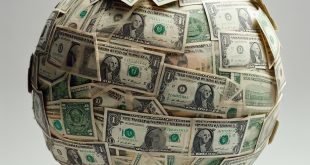The US central bank is to notch up on Wednesday its efforts to withdraw the stimulus it showered on the US economy after the pandemic upended global economies two years ago. Fed officials are expected to raise the benchmark rate by a half percentage point and approve plans to start shrinking their $9 trillion asset purchases portfolio.
The Fed’s plan to reduce the size of its balance sheet is part of a broader strategy at the central bank to more urgently combat elevated inflation. Fed officials have discussed allowing up to $60 billion in Treasury bonds to mature each month as part of the reduction. Treasury, in turn, will have additional borrowing needs as it seeks to replenish its cash balances due to the Fed’s redemptions.
Despite the potential for Fed redemptions, lower borrowing needs driven by strong tax receipts allowed for the additional decreases in coupon auction sizes announced Wednesday, according to a Treasury official. Treasury said its issuance plans leave it well positioned to finance borrowing needs that may arise from Fed redemptions and that additional cuts may be necessary in future quarters.
The moves are part of a double-barreled effort to slow the economy and ease price pressures that are at a four-decade high. One specter haunting the Federal Reserve meeting Wednesday is the prospect that the low inflation environment of recent decades is now giving way toward persistently higher inflation pressures.
That could have a seismic impact on how monetary policy is conducted in future years. Last month, the leader of the Bank for International Settlements warned of just such a risk. The forces behind high inflation could persist for some time.
New pressures are emerging, not least from labor markets, as workers look to make up for inflation-induced reductions in real income. Some of the structural disinflationary winds that have blown so intensely in recent decades may also be waning, and there are signs that globalization may be retreating” on pandemic aftershocks and geopolitical risks.
Fed officials remain confident they’ll get inflation under control and when asked, they’ve largely brushed off questions about whether a new inflation regime has arrived. But some are thinking about it.
Minneapolis Fed leader Neel Kashkari told Axios in late April that “there are signs that maybe the economy has moved to a new high-pressure equilibrium … If that’s in fact the case, then we’re going to have to act pretty aggressively at the Fed to bring it back down into a regime that’s consistent with our 2% target.” He added, however, that “I still think that those fundamental forces that led to a low-inflation, low-growth environment are still there.”
Treasury Secretary Janet Yellen said the US economy remains strong despite the fact that it shrank in the first quarter of this year, adding that inflation is too high and needs to be reduced. Yellen added that she believes that Congress could still approve elements of the global minimum tax deal secured last year and expects the EU will approve the minimum tax plan this spring.
Strong demand coupled with shortages for select goods and services one year ago led to a surge in inflation. Fed officials expected it would eventually subside as supply chains healed.
But over the last six months, officials have grown more anxious about inflation running above the central bank’s 2% target for much longer than they previously expected, even after any reversal of last year’s extreme price increases for items such as used cars, because of signs that labor markets are extremely tight and that price pressures are broadening to include more labor-intensive services.
Consumer prices rose 6.6% in March from a year before, as measured by the Fed’s preferred inflation gauge, the Commerce Department’s personal-consumption expenditures price index, to a new four-decade high. Core consumer prices, which exclude volatile food and energy items, rose 5.2%, down from a gain of 5.3% in February.
Among the questions facing Fed officials: Where do they think inflation is likely to settle if the rate of growth slows later this year, as many economists and Fed officials have anticipated? And second, what level of inflation would be so unacceptably above their 2% target that it would justify pushing rates beyond a neutral rate that is estimated to be between 2% and 3% when underlying inflation is around 2%?
Fed’s Charles Evans said last month that even after accounting for expected declines in the prices of certain consumer goods that increased sharply last year, he thought inflation would be running around 3% or 3.5% by year’s end. On the other hand, if inflation were to fall to 2.5%.
Fed Chairman Jerome Powell is shifting monetary tightening into a higher gear. His goal sounds straightforward; yo lift interest rates to “neutral,” a setting that neither spurs nor slows growth. The Fed’s policy statement continues to serve as the main vehicle for expressing the consensus view of the central bank’s rate-setting committee, though it has received somewhat less attention in recent months because, compared to Chairman Jerome Powell’s press conference, it has provided less information about the central bank’s policy intentions.
One question is whether the Fed will at some point reintroduce more forward guidance, or the words they use to describe their intentions for interest rates over the coming months. Forward guidance has been an important part of the Fed’s monetary-policy arsenal for most of the past two decades, a period in which inflation and interest rates have generally been low.
The Fed first relied on such conditional promises—often cloaked in adjectives that became fraught with significance—in the early 2000s. Officials initially employed the tactic in 2003 when they wanted to signal plans to keep rates low and later to signal coming rate increases in a manner that wouldn’t bulldoze markets, as had occurred in 1994, when the Fed raised rates sharply.
Before commencing rate rises in 2004, the Fed said such increases were likely to proceed at a “measured” pace. They subsequently raised rates by a quarter-percentage point at 17 consecutive policy meetings. In 2015, the Fed prepared markets for an even milder path of rate rises by telegraphing such increases would be “only gradual.”
But the economic environment today—one with much greater uncertainty about how labor markets, wages, and inflation will unfold—has made Mr. Powell and his colleagues more reticent to provide such clues or assurances. Some analysts believe the Fed got into trouble last year by providing strong guidance about its policy intentions that made it more difficult to shift course as inflation continued to defy expectations by broadening out to more goods and services.

 Noor Trends News, Technical Analysis, Educational Tools and Recommendations
Noor Trends News, Technical Analysis, Educational Tools and Recommendations




